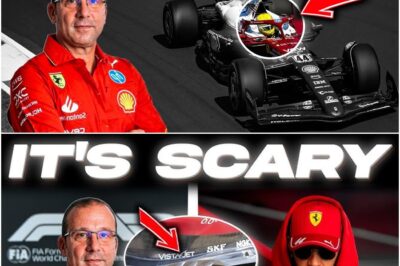With every passing F1 season comes a fresh opportunity for some of the greatest minds in motorsport to bash their heads together and potentially come up with a technical innovation that will help them to succeed on track.
To name a few, we had Williams introduce the highly advanced active suspension in the late 1980s, which led them to multiple world titles, as well as a double diffuser on the 2009 Brawn GP car that led them to a fairy tale world championship against all odds.
More recently, we had the Mercedes come out with the dual-axis steering system, which seemed to turn their F1 car into a Batmobile as it cheekily changed the toe of the front tyres to enable a more efficient heating process.
But it was an innovation from McLaren in 2010 which has had the biggest impact on F1 for future years, with their introduction of their RW80 mechanism, more commonly known as the F-duct.
McLaren’s F-duct device made teams scramble to copy the ingenious design during the 2010 F1 season
When McLaren introduced their new MP4-25 ahead of the 2010 F1 season, analysts scrambled to figure out the use of having a little inlet in front of the cockpit would have on the car’s performance.
Then came the onboard cameras of Lewis Hamilton and Jenson Button, seemingly taking their hands off the steering wheel down the straights of the Albert Park, and the real reason for the innovation came to light.
Seeing the straight-line speed advantage that the McLarens had over the rest of the field, F1 teams scrambled to try and copy the ingenious design as soon as possible.
The Woking-based outfit didn’t seem to benefit from the innovation, however, due to the list of deficiencies that the MP4-25 had in other areas. Despite this, then-Red Bull team principal Christian Horner called for the idea to be banned.
“It is a clever piece of engineering and hats off to the guys who invented it, but some of the solutions this weekend look a bit marginal when you see drivers driving with finger tips and no hands,” he told the media, via Sky Sports. “So I think there is a safety issue and a cost issue to take into account.”
Dubbed the F-duct due to its location above the letter F in McLaren’s title sponsor Vodafone, the device was swiftly banned for the 2011 season after the Spanish Grand Prix in May.
The innovation inspired the FIA in their creation of the Drag Reduction System (DRS)
Following the ban on the F-duct, which was due to take effect in the 2011 season, the FIA created a safer alternative for teams to reduce the amount of drag on straights by introducing the Drag Reduction System, otherwise known as its acronym, DRS.
The system operates under a similar philosophy to the F-duct, negating all downforce flowing over the rear wing in a much more controlled manner, requiring a button press on the steering wheel rather than having to cover a hole in the cockpit.

Photo by Darren Heath/Getty Images
At first, circuits featured just one DRS zone, with some tracks having a second one added after the 2011 Spanish Grand Prix to further promote the chance of overtaking for drivers.
Despite the swift ban on the inlet, the innovation led to McLaren being presented with the Pioneering and Innovation Award at the 2010 Autosport Awards, giving the engineers something to cheer about, at the very least.
The 2025 season will be the final year of the F-duct’s legacy, with DRS being scrapped for the 2026 season. Cars next year will instead feature a push-to-pass button similar to that in other single-seater categories across the globe.
News
Lando Norris’ dream of becoming F1 champion in 2025 is not over yet. Despite fierce competition, he still has a shot. What steps must he take to secure the title, and could he pull off the ultimate upset in the final races of the season?
How Lando Norris Can Still Win the 2025 F1 Title: A Realistic Breakdown Formula 1 seasons rarely fail to deliver…
Max Verstappen’s reaction to Red Bull’s disastrous performance has sent shockwaves through the paddock. Furious at his team’s lack of preparation, Verstappen makes it clear that frustration is at an all-time high. Is this the breaking point for the reigning champion and his relationship with Red Bull?
Max Verstappen’s Frustrations with Red Bull and Racing Bulls: A Closer Look at the Current F1 Drama Max Verstappen, the…
Ferrari Transfer Drama: Max Verstappen’s SHOCKING Response to the Rumors and Hamilton’s HORRIBLE 2025 Season Forecast: Max Verstappen breaks his silence on the ongoing Ferrari transfer speculation, alongside his bold take on Lewis Hamilton’s future in Formula 1. Will 2025 really be Hamilton’s worst season ever?
Max Verstappen, Lewis Hamilton, and Ferrari: The Unfolding Drama at Monza The Monza Grand Prix is more than just another…
After a dramatic qualifying session at the Monza GP, Ferrari engineers have detected a critical issue in Hamilton’s car that could have major implications for the rest of the weekend. What exactly did they find, and how might it affect his race strategy and chances of victory?
Ferrari’s Game-Changing Discovery at Monza: The Road to 2025 Glory Monza 2025 will go down in history not only as…
Ferrari’s aggressive performance at Monza has put McLaren in a tense situation, with Antonelli facing the latest setback. The pressure is mounting, and the Italian team’s relentless drive for victory is only intensifying the stakes. Will McLaren be able to respond, or is this the breaking point?
Lando Norris Fastest on the Opening Day of the Italian Grand Prix as Kimi Antonelli Endures a Day to Forget…
Sky Sports issue apology as F1 star furious with rival swears during live interview!
An incident during qualifying for the Italian Grand Prix led to Racing Bulls driver Isack Hadjar turning the air blue…
End of content
No more pages to load












